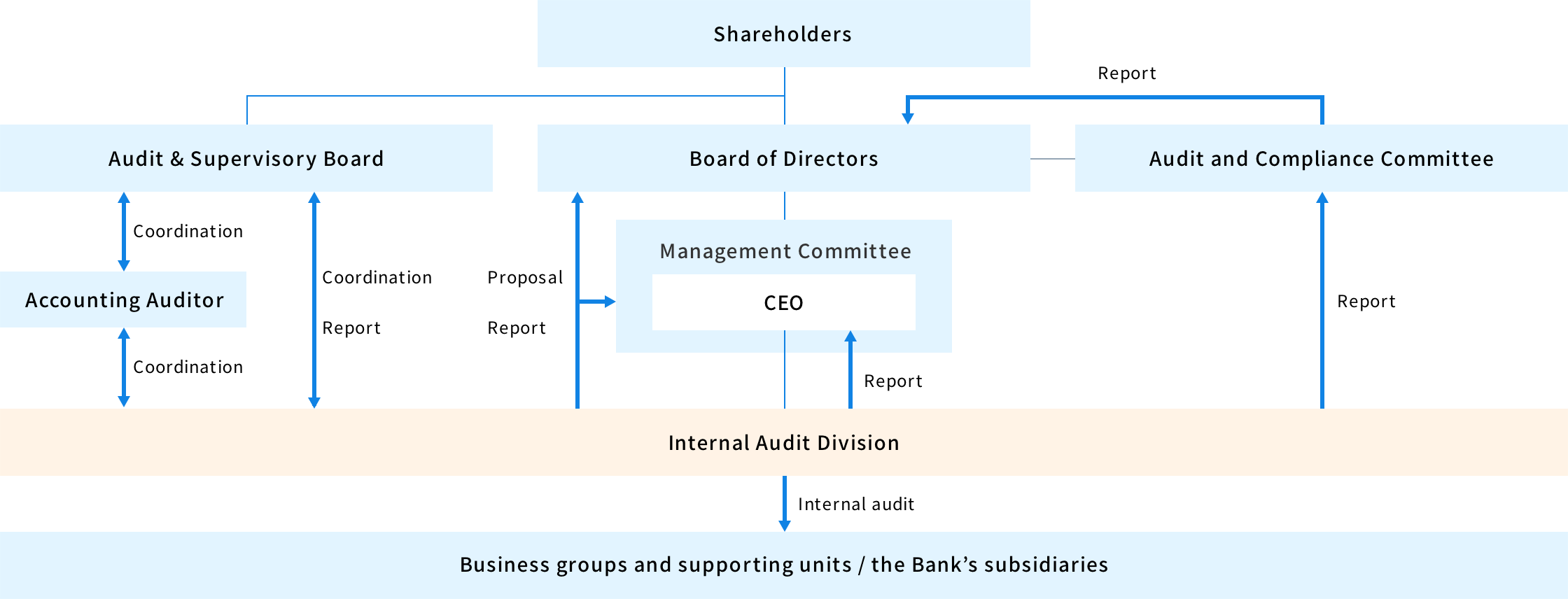Corporate Governance
1. Corporate Governance Philosophy
The objective of establishing Aozora's corporate governance policy is to ensure management discipline and to create a framework of checks and balances in order to continue reflecting our management philosophy in the execution of our daily business operations. For this purpose, Aozora Bank continues to work toward a more transparent corporate governance structure by focusing on the proper establishment and operation of its governance framework as an important management initiative.
Management adheres to compliance with laws and regulations in all areas of business execution. Management identifies a broad range of risks that regularly occur in business operations and assesses their potential impact on the Bank's business in order to ensure optimal transparency, maintain strong internal controls and strengthen the framework for the effective balancing of risk and return.
In order to improve efficiency through the separation of management oversight and business execution as well as transparency by establishing an appropriate corporate governance system, the Board of Directors, including outside directors, determines our basic management policy and management strategies, and oversees the execution of business operations. Executive officers, including Representative Directors, conduct daily business operations with authority delegated to them by the Board of Directors.
The Management Committee is the highest decision-making body for the execution of daily business, and is comprised of members from among executive officers, who are approved and appointed by the Board of Directors. This structure improves the speed of decision-making, while at the same time the Executive Officers' Meeting, which comprises all executive officers, is held in order to exchange important information. Sub-committees are also established to improve efficiency of the execution of business operations.
The Audit & Supervisory Board (ASB) and its members monitor and verify the execution of director duties, mainly from a legal perspective. Committees, such as the Nomination and Remuneration Committee and the Audit and Compliance Committee, both of which are mainly comprised of outside directors, are entrusted by the Board of Directors to perform supplementary supervision of representative directors and executive officers and function as a check and balance on management.
<Board of Directors>
The Board of Directors establishes important basic policies for business operations and oversees the execution of duties by executive officers entrusted with daily business operations. Moreover, the outside directors' meetings include only four outside directors and are convened multiple times throughout the year to allow for the discussion and exchange of views on topics, including Aozora’s executive structure, key business issues and the operation of the Board of Directors, from an independent outside director's perspective.
<Audit & Supervisory Board>
The Bank operates under the Audit & Supervisory Board (ASB) system. The ASB performs business and accounting audits regarding the execution of duties by directors and executive officers in accordance with relevant laws and regulations. ASB meetings are held with all ASB members attending to receive reports on important audit matters and discuss or resolve them as needed.
<Nomination and Remuneration Committee>
The Nomination and Remuneration Committee, the majority of which is comprised of outside directors, provides the Board of Directors with recommendations, including prospective candidates for Board and ASB members as well as other important employees. In addition, the Nomination and Remuneration Committee determines the remuneration of directors and executive officers and makes recommendations to each ASB member regarding their remuneration.
<Audit and Compliance Committee>
The Audit and Compliance Committee, which is comprised of outside directors, reviews the adequacy and effectiveness of matters relevant to the establishment of internal control systems, including internal and external audits, risk management, compliance, and credit audits.
<Management Committee>
For the execution of business below the Management Committee level, the Aozora Group is committed to developing proper and efficient operations through the development of internal rules and material revisions to them, enhancement of the risk management structure, and internal audits by the Internal Audit Division, in accordance with the basic policy for building the internal control system approved by the Board of Directors, the basic policy for compliance with laws and regulations, and the basic policy for risk management.
The Management Committee meets weekly and determines important matters related to the Bank's execution of daily business in accordance with the policies set forth by the Board. The Management Committee has the following sub-committees to which it delegates authority: ALM Committee, Integrated Risk Committee, Credit Committee, Investment Committee, CAPEX Committee, Customer Protection Committee and Sustainability Committee. Sub-committees are comprised of members with substantive knowledge and experience in multiple aspects of the Bank's business operations, as well as sound decision-making capabilities.
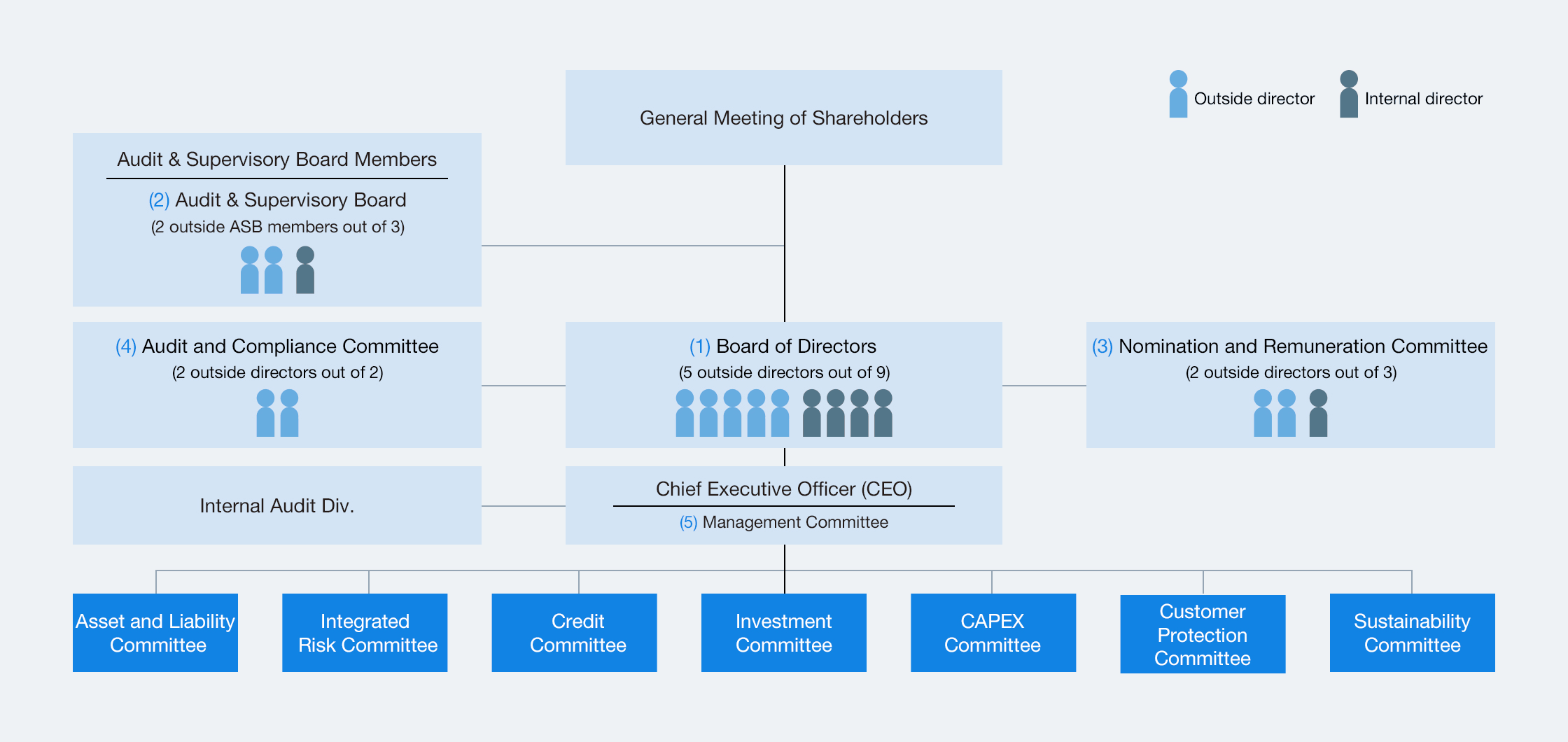

Ratio of outside directors
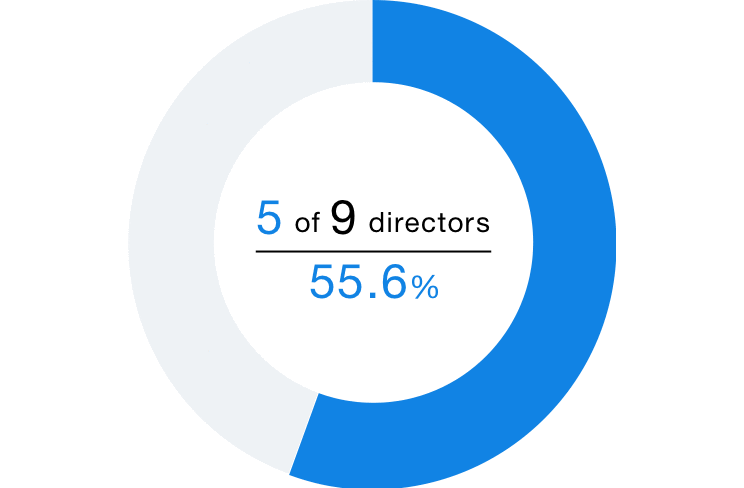
Ratio of female directors
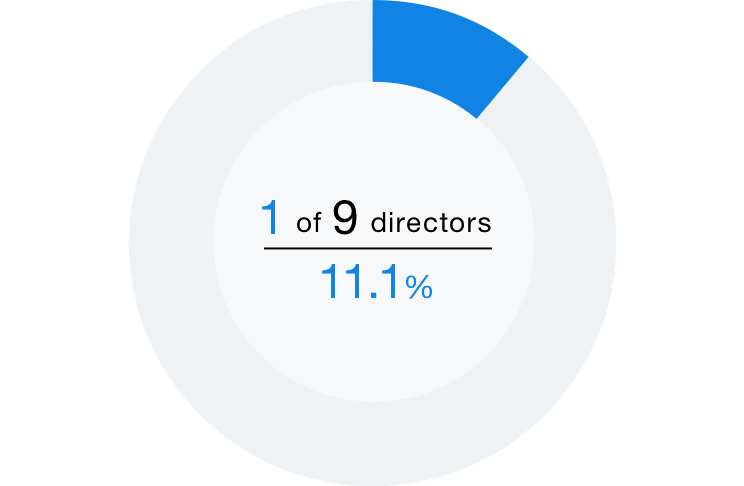
Director’s length of tenure
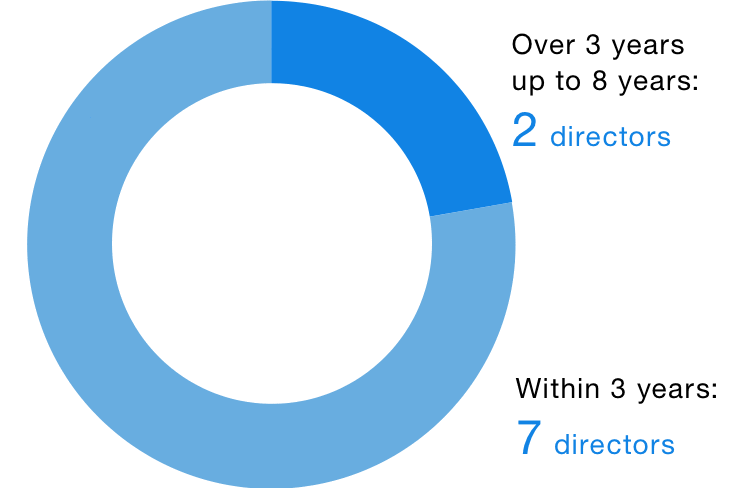
- As of July 1, 2023
All the outside directors and outside Audit & Supervisory Board members satisfy the requirements
for independence set forth by the Tokyo Stock Exchange and the Bank's "Independence Criteria for Outside Directors and Outside Audit & Supervisory Board Members."
All qualified outside directors and outside Audit & Supervisory Board members are designated as independent.
Outside Director (4 members)
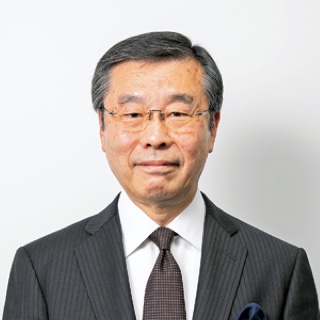
Outside Director (Independent)
Ippei Murakami
|
Length of tenure |
9 years |
|---|---|
|
Board meeting attendance |
100% |
|
Aozora shares owned |
9,958 |
Mr. Ippei Murakami has served as President and Representative Director of Nisshin Seifun Group Inc. and Chair of the Board of Trustees of Kwansei Gakuin and he has a wealth of experience, credentials and deep insight as a member of senior management of a corporate institution and an educational institution, as well as extensive knowledge of corporate finance and accounting. He has appropriately supervised the management of the Bank as an Outside Director since June 2014.
The Bank has high regard for his experience and capabilities and expects him to provide overall oversight and advice on the execution of duties by executive officers, from an objective perspective, toward the enhancement of the Bank’s corporate value over the medium- to long-term. The Bank has therefore continued his appointment as Outside Director.
What do you most hope to achieve through the new Mid-term Plan “Aozora 2025”?
Society has changed significantly in the wake of the COVID-19 pandemic, and combined with long-lasting low interest rate policies, even the financial industry has been forced to shift its focus away from operations centered on over-the-counter banking, which had been its traditional earnings base.
That is to say, the expectations placed on banks have changed. Banks have traditionally collected funds from corporate institutions and retail customers through a large number of branches and employees and managed such funds through loans and other services. Now, banks are being required to contribute directly to the objectives of corporate customers, such as business expansion and succession. They are also required to act as intermediaries for retail customers to help them achieve their goals—not only the universal goal of earning interest income but also goals in areas of lifelong growth, including further education, as well as inheritance and stability in retirement. In other words, banks that are capable of doing these things are the ones that are chosen by customers. It is not a question of how many branches and employees they have; what’s important are the capabilities of each and every employee, their collective capabilities as an organization, and how effectively they can be used by customers.
The new Mid-term Plan “Aozora 2025” aims for us to become exactly this kind of bank. Aozora’s employees are sufficiently qualified to respond to these requirements, and the bank’s size is well suited for these goals.
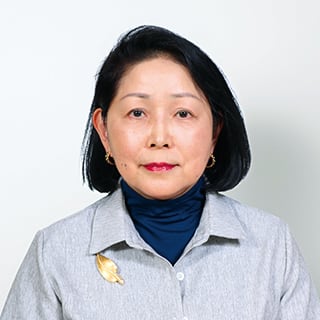
Outside Director (Independent)
Sakie Tachibana Fukushima
|
Length of tenure |
1 year |
|---|---|
|
Board meeting attendance |
100%* |
|
Aozora shares owned |
340 |
Ms. Sakie Tachibana Fukushima has served as Director of Korn/Ferry International (U.S. Headquarters), a U.S. listed firm, as well as President and Chairman of Korn/Ferry Japan. She has also served as an outside director of several Japanese listed companies and has a wealth of experience, credentials and deep insight as a member of senior management of corporate institutions, as well as extensive knowledge of the management of global human resources and corporate governance. She has appropriately supervised the management of the Bank as an Outside Director since June 2022.
The Bank has high regard for her experience and capabilities and expects her to provide overall oversight and advice on the execution of duties by executive officers, from an objective perspective, toward the enhancement of the Bank’s corporate value over the medium- to long-term. The Bank has therefore continued her appointment as Outside Director.
*For the Board of Directors meetings held in the fiscal year ended March 31, 2023, after her appointment as Director.
What were the key points discussed during the process of formulating the new Mid-term Plan “Aozora 2025”?
Last year, the financial industry went through major upheavals due to factors such as bank failures in Europe and the U.S. Globalization and digitalization, which had been advancing prior to the COVID-19 pandemic, had to be redefined in light of heightened geopolitical risks.
Taking these changes in the external environment as a period of transformation, we have formulated the new Mid-term Plan “Aozora 2025,” with the aim of establishing the "Aozora's Strategic Investments Business” model. In the first year of the plan, we will work together across the entire Group to enhance corporate value by leveraging the characteristics of each business, under the key words “Fostering, Change, and Recovery,” which are the three phases where the Group will leverage its strengths. Outside directors participated in discussing these key points, reconfirming our strengths and weaknesses as a financial institution and organization, and discussing the appropriateness of our strategies in light of market trends.
Aozora has agility that allows it to adapt to changing times. Since strategy is all about execution and results, we confirmed the importance of the following foundational points: 1) investment in human capital, such as hiring and training professionals to enable the placement of the right people in the right places, including reskilling; 2) raising the awareness of all employees to enable cross-sectional optimization throughout the Group; and 3) speedy implementation of strategies. We will continue to closely monitor, supervise and support the execution of these strategies this fiscal year.
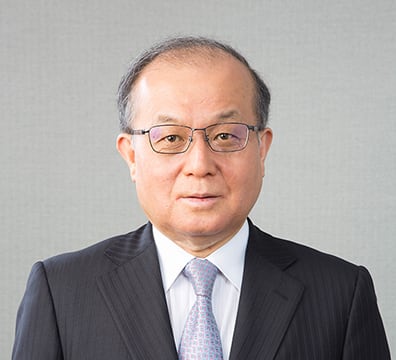
Outside Director (Independent)
Hideyuki Takahashi
|
Length of tenure |
ー |
|---|---|
|
Board meeting attendance |
ー |
|
Aozora shares owned |
ー |
Mr. Hideyuki Takahashi has served as Deputy President and Group CFO, and Deputy Chairman of the Board of Directors of Mizuho Financial Group, Inc. as well as Representative Director and President of Mizuho Research & Technologies, Ltd. and he has a wealth of experience, credentials and deep insight as a member of senior management of corporate institutions in the banking and non-financial sectors, as well as extensive knowledge of finance and accounting and corporate governance of financial institutions.
The Bank has high regard for his experience and capabilities and expects him to provide overall oversight and advice on the execution of duties by executive officers, from an objective perspective, toward the enhancement of the Bank’s corporate value over the medium- to long-term. The Bank has therefore appointed him as Outside Director.
A message to our shareholders (at the time of appointment)
I joined the Industrial Bank of Japan (currently Mizuho Bank, Ltd.) in 1980. During my banking career, I have been mainly responsible for corporate management and financial strategies, and after the holding company had transitioned to a Company with Nominating Committee, etc., I was engaged in governance reform as Deputy Chairman of the Board of Directors, Chairman of the Audit Committee and Chairman of the Risk Committee. At present, corporate management of financial institutions are facing two significant challenges. One is that we are facing the need to redefine our raison d’etre as a financial institution, as the progress of ESG and digitalization lead to discontinuous changes in social and economic structures and transform the existing values themselves.
The other is the need to respond to constant materialization of unexpected risks such as extreme weather events and the Ukraine crisis. In order to ride out these major trends, it is important for the executive officers to have management skills with speed and resilient responsiveness. I believe corporate governance underpins these management skills and its keystone is the Board of Directors.
With my experience in the management of financial institutions, I’ll do my best to contribute to the sustainable growth of the Bank as an Outside Director.
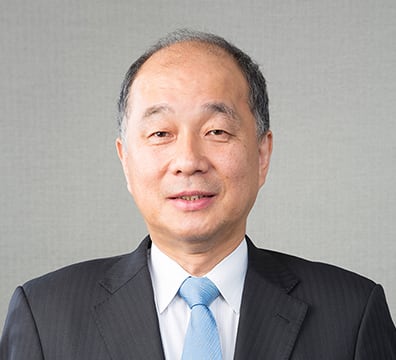
Outside Director (Independent)
Hideaki Saito
|
Length of tenure |
ー |
|---|---|
|
Board meeting attendance |
ー |
|
Aozora shares owned |
ー |
Mr. Hideaki Saito has served as President and CEO of AXA Direct Life Insurance Co., Ltd., President and CEO of Japan Systems Co., Ltd. and Partner of consulting firms and he has a wealth of experience, credentials and deep insight as a member of senior management of corporate institutions and as a strategic consultant, as well as extensive knowledge of DX/IT.
The Bank has high regard for his experience and capabilities and expects him to provide overall oversight and advice on the execution of duties by executive officers, from an objective perspective, toward the enhancement of the Bank’s corporate value over the medium- to long-term.
A message to our shareholders (at the time of appointment)
I’ve worked in the financial and IT industries and gained management experience as president.
In addition, as a management consultant, I’ve worked on a variety of management issues in many industries, not limited to finance and IT, and have had firsthand experience of the management styles and governance models of Japanese, American and European companies.
I’ll provide the essence of these diverse experiences in order to maximize the Bank’s corporate value. For example, in the IT area, I believe it is important to consider from the business model development stage, not only the efficiency of IT investment, but also the areas that should be strengthened to demonstrate Aozora’s unique characteristics, areas where efficiency should be pursued, and areas where we should not explore. It is also essential to keep up with constantly evolving technology trends.
I’ll do my best to contribute to maximizing corporate value by pursuing the strengths of the Bank from the perspective of our shareholders.
Outside Audit & Supervisory Board Member (2 members)
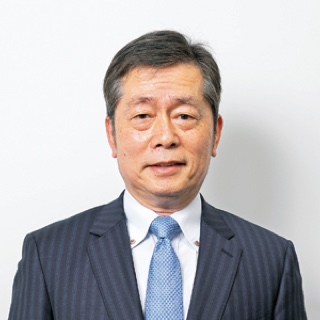
ASB Member (Independent)
Toraki Inoue
|
Length of tenure |
7 years |
|---|---|
|
Board meeting attendance |
100% |
|
ASB meeting attendance |
100% |
|
Aozora shares owned |
― |
Reason for appointment
Mr. Toraki Inoue was formerly a Worldwide Partner at Arthur Andersen and is qualified for the responsibilities as an Outside Audit & Supervisory Board Member because he has substantial experience and expertise as a public accountant and accounting expert, and his position is independent from the day-to-day management responsibilities of the operations and activities of the Bank.
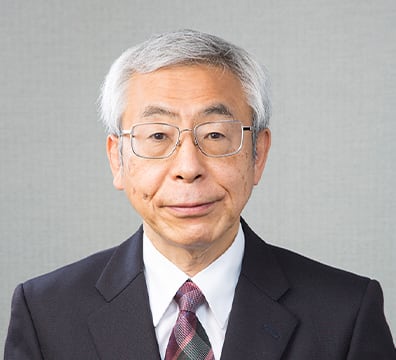
ASB Member (Independent)
Junichi Maeda
|
Length of tenure |
ー |
|---|---|
|
Board meeting attendance |
ー |
|
ASB meeting attendance |
ー |
|
Aozora shares owned |
― |
Reason for appointment
Mr. Junichi Maeda is qualified for the responsibilities as an Outside Audit & Supervisory Board Member because he has substantial experience and expertise in the finance and banking business, and his position is independent from the day-to-day management responsibilities of the operations and activities of the Bank.
Internal Director (4 members)
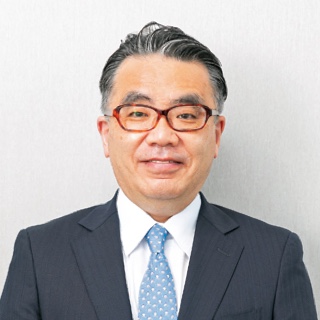
Representative Director and President,
Chief Executive Officer (CEO)
Kei Tanikawa
|
Length of tenure |
5 years |
|---|---|
|
Board meeting attendance |
100% |
|
Aozora shares owned |
20,123 |
Reason for appointment
Mr. Kei Tanikawa has been engaged in a broad range of banking businesses such as corporate banking and financial institutions and has made a considerable contribution to the corporate management as an Executive Officer (since July 2012), with responsibility for multiple groups/divisions. He has led all of the Aozora Group as Representative Director, President and Chief Executive Officer (since June 2020), after serving as Representative Director, Deputy President (since June 2018) and has a thorough knowledge of the Group’s overall business operations. He has deep insight in financial businesses as well as extensive experience and sound judgment.
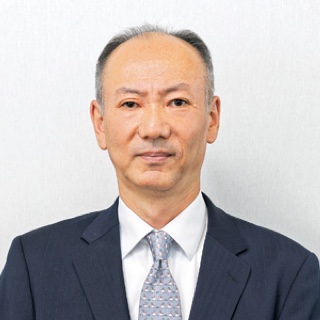
Representative Director and Deputy President
Koji Yamakoshi
|
Length of tenure |
3 years |
|---|---|
|
Board meeting attendance |
100% |
|
Aozora shares owned |
5,014 |
Reason for appointment
Mr. Koji Yamakoshi has been engaged in a broad range of banking businesses such as specialty finance and has made a considerable contribution to the corporate management as an Executive Officer (since July 2012) and subsequently Head of the Specialty Finance Group and Head of the Corporate Banking Group. He has been responsible for a wide range of business operations and involved in the overall management of the Group as Representative Director and Deputy President (since June 2021), and he has a thorough knowledge of the Group’s overall business operations. He has deep insight in financial businesses as well as extensive experience and sound judgment.
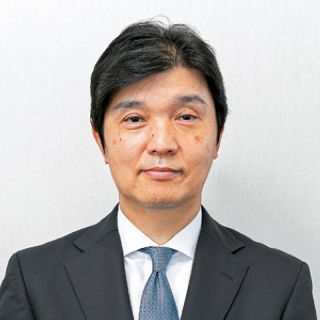
Representative Director and Deputy President
Hideto Oomi
|
Length of tenure |
2 years |
|---|---|
|
Board meeting attendance |
100% |
|
Aozora shares owned |
9,718 |
Reason for appointment
Mr. Hideto Oomi has been engaged in a broad range of banking businesses such as corporate banking and corporate strategy and has made a considerable contribution to the corporate management as an Executive Officer (since July 2016), supervising multiple groups/divisions. He has been involved in the overall management as Representative Director and Deputy President (since June 2021), has also led institutional banking business activities as Head of the Institutional Business Promotion Group, and has a thorough knowledge of the Aozora Group’s overall business operations. He has deep insight in financial businesses as well as extensive experience and sound judgment.
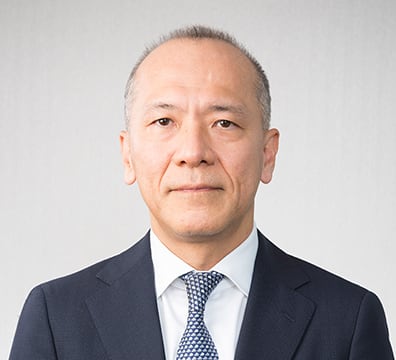
Director and Senior Managing Executive Officer
Masayoshi Ohara
|
Length of tenure |
ー |
|---|---|
|
Board meeting attendance |
ー |
|
Aozora shares owned |
2,183 |
Reason for appointment
Mr. Masayoshi Ohara has been engaged in a broad range of banking businesses such as the markets business and has made a considerable contribution to the corporate management as an Executive Officer and Head of the Financial Markets Group (since July 2014) and subsequently CRO and CCRO. He has deep insight in financial businesses as well as extensive experience and sound judgment.
Standing ASB Member (1 member)
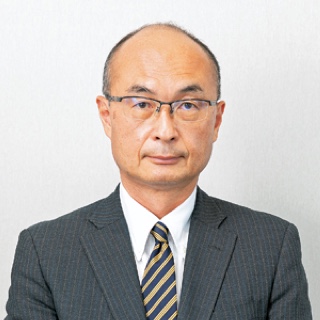
Standing ASB Member
Satoshi Hashiguchi
|
Length of tenure |
5 years |
|---|---|
|
Board meeting attendance |
100% |
|
ASB meeting attendance |
100% |
|
Aozora shares owned |
1,964 |
Reason for appointment
Mr. Satoshi Hashiguchi has been engaged in a broad range of banking businesses such as corporate banking, financial management and markets and became General Manager of the Internal Audit Division in October 2013. With his extensive experience and deep insight, he has been verifying internal controls from an objective standpoint independent of business execution as General Manager of the Internal Audit Division.
- Length of tenure refers to service as of June 22, 2023.
- Board meeting and ASB meeting attendance refers to meetings held during FY2022.
- Number of Aozora shares owned as of March 31, 2023


|


|
|---|---|
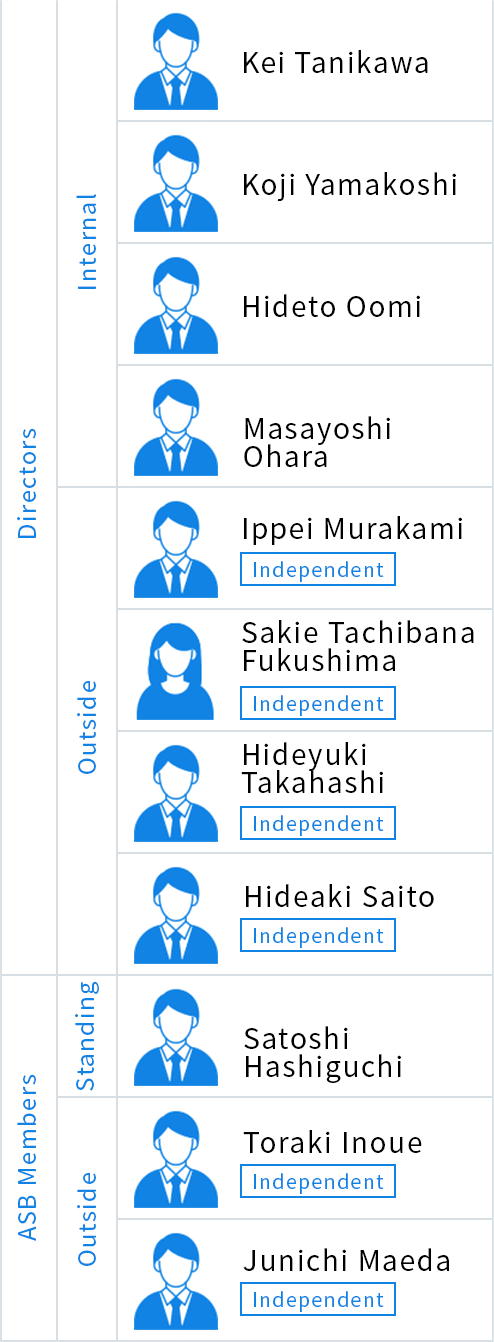

|
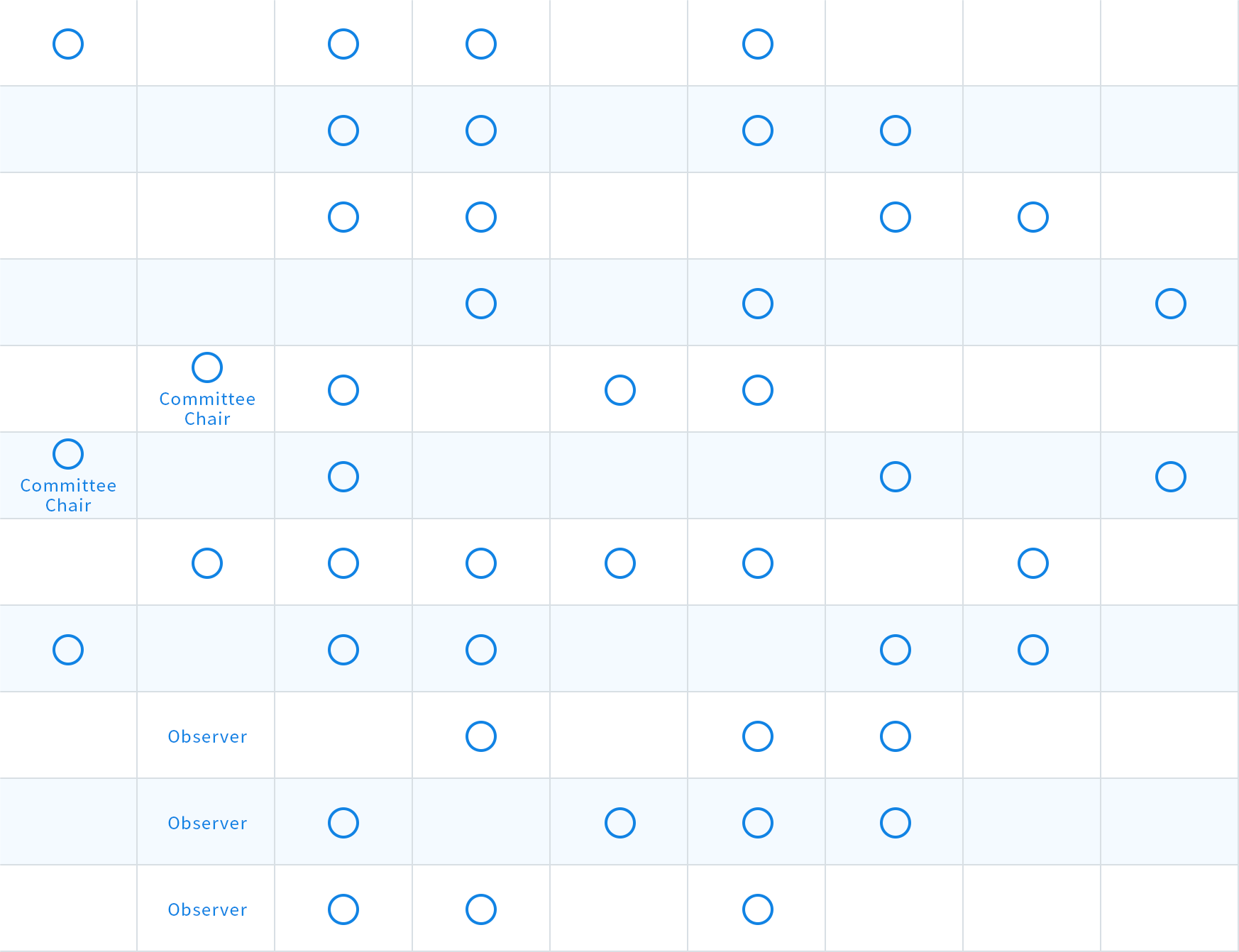

|
- Not all of the expertise that each Director or Audit & Supervisory Board Member possesses
- The Board of Directors shall not have more than 12 Directors, which is the maximum number of Directors stipulated in the Articles of Incorporation.
- Nomination of Director candidates shall be based on the “Basic Policy for Nominating Director and Audit & Supervisory Board Member Candidates, and Appointing and Dismissing Senior Management Including the CEO.”
- The composition of the Board of Directors shall take into consideration diversity and mix of experience, with a wealth of knowledge and expertise in areas including banking and finance, financial accounting, risk management, legal and compliance, and so forth, in addition to deep insight of the Aozora Group's business.
- The Board of Directors shall be comprised of internal directors who possess extensive knowledge and experience in business execution and outside directors who supervise management from an objective standpoint. Judgement of outside director’s independence shall be made based on the “Independence Criteria for Outside Directors and Outside Audit & Supervisory Board Members” and the percentage of independent outside directors, in principle, shall be a half or more.
The Bank works to further enhance the effectiveness of its Board of Directors through a continuous process (PDCA cycle) of analyzing and evaluating Board effectiveness each fiscal year as well as considering and providing solutions to new and existing issues.
In light of its fiduciary duties and accountability to the Bank's shareholders, the Board of Directors continues to perform self-evaluations of its effectiveness, based on a questionnaire of all members of the Board present during the target period, with the aim of promoting sustainable growth and enhancing the Bank's corporate value over the medium- to long-term based on the assessment of and views on its management and oversight functions that leverage directors' and Audit & Supervisory Board members' knowledge, experience and capabilities. The results of these self-evaluations are shared after thorough Board discussions.
The Bank’s Board of Directors ensures objectivity and transparency as 50% of the Board are outside members.
In addition to retaining an Audit & Supervisory Board, the Bank also has the Nomination and Remuneration Committee, which is mainly comprised of outside directors and is also chaired by an outside director, as well as the Audit and Compliance Committee, which is comprised of only outside directors. Both committees act to complement the oversight of executive officers including representative directors and conduct checks and balances of them.
Outside directors’ meetings were convened twice throughout FY2022 to allow for the discussion and exchange of views on multiple topics, including Aozora’s executive structure, key business issues in light of the rapidly changing business environment, and the operation of the Board of Directors, from an independent outside director’s perspective. The Board of Directors conducted a review of the previous Mid-term Plan and received progress reports mainly on Aozora’s Strategic Investments Business, as well as Aozora’s Platform Business. Following this, topics discussed at the Board of Directors meeting were incorporated into the Bank’s management, and substantive discussions regarding the development of the new Mid-term Plan (FY2023–2025) took place over the course of several sessions, and through multiple discussions on the key themes, the plan was formulated. The Board of Directors also discussed and considered a clearer description of the composition of the Board of Directors and the independence criteria for outside directors, including the CEO’s succession plan and the tenure of the outside directors. Furthermore, the Board approved candidates for independent outside director and outside Audit & Supervisory Board member that the Nomination and Remuneration Committee recommended after discussions.
In FY2022, the Board assessed that its roles and responsibilities continued to be properly fulfilled under the aforementioned framework through constructive discussions and an exchange of ideas on important issues, including business strategy, as well as the highly effective oversight and monitoring of management executives. The Board also assessed that overall Board management was proper and effective.
The Board of Directors for FY2023 will strive to make the Board’s roles and responsibilities more effective and proper by engaging in management issues based on the self-evaluation and conducting a PDCA cycle while utilizing committees under the Board as well as the outside directors’ meeting.
|
Name of Committee |
Chaired by |
Members |
Meetings held in FY2022 |
|---|---|---|---|
|
Board of Directors |
President |
Directors, ASB Members |
15 |
|
Audit & Supervisory Board (ASB) |
Standing ASB Member |
ASB Members |
14 |
|
Nomination and Remuneration Committee |
Outside Director |
Directors (Outside Directors comprise majority) |
7 |
|
Audit and Compliance Committee |
Outside Director |
Outside Directors |
6 |
Specific matters discussed in the Board of Directors meetings in FY2022 were as follows.
- Confirm progress of the previous Mid-term Plan
- Discuss formulation of the next Mid-term Plan
- Sustainability initiatives
- ALM securities portfolio management status and response policy
- Nomination of independent outside director and Audit & Supervisory Board member candidates
- Set maximum tenure period for outside directors and outside Audit & Supervisory Board members
- Integrated risk report, compliance program, Annual Internal Audit Plan
- Financial report, earnings forecast announcement, dividends
- Others
Specific matters discussed in the Nomination and Remuneration Committee meetings in FY2022 were as follows.
- Compensation plan for sustainable growth and compensation amount
- Nomination of director and executive officer candidates
- Set maximum tenure period for outside directors and outside Audit & Supervisory Board members
- CEO successor plan
- Others
Specific matters discussed in the Audit and Compliance Committee meetings in FY2022 were as follows.
- Status of internal audit
- Matters regarding integrated risk management
- Status of progress of the compliance program
- Status of asset assessment
- Others
|
Name of Committee |
Chaired by |
Members |
Meetings held in FY2022 |
Purpose |
|---|---|---|---|---|
|
Management Committee |
CEO |
Executive Officers appointed by the Board of Directors |
57 |
Determine important matters related to daily business operations |
|
Asset and Liability Management Committee |
CFO |
President, Executive Officers in charge |
21 |
Deliberate on and determine important matters regarding asset and liability management, including plans for the sources and uses of funds |
|
Integrated Risk Committee |
CRO |
President, Executive Officers in charge |
11 |
Deliberate on establishing risk management policies, monitoring the risk management framework, maintaining proper internal governance and launching new businesses/products |
|
Credit Committee |
CCRO |
President, Executive Officers in charge |
69 |
Establish a credit risk asset portfolio aligned with management policies through approval of individual credit transactions |
|
Investment Committee |
CCRO |
President, Executive Officers in charge |
46 |
Approve individual investment transactions, establish appropriate investment policies, ensure accurate understanding of the Bank's overall investment risk, build and maintain a secure and profitable portfolio |
|
CAPEX Committee (approval and management of IT-related proposals) |
CTO |
President, Executive Officers in charge |
13 |
Approve and monitor IT projects required to realize business plans and strategies |
|
CAPEX Committee (approval and management of facilities-related proposals) |
Head of Corporate Strategy Unit |
President, Executive Officers in charge |
9 |
Approve and monitor facilities-related proposals required to realize business plans and strategies |
|
Customer Protection Committee |
Head of Compliance and Governance Unit |
Executive Officers in charge |
18 |
Establish and improve the customer protection framework in five areas: customer explanation management, customer support management, customer information management, outsourcing management and conflict of interest management |
|
Sustainability Committee |
CEO |
Executive Officers in charge |
9 |
Deliberate on and determine basic matters of sustainability promotion as well as important matters regarding sustainability promotion in the Bank’s business and initiatives as a business entity |
<Basic Guidelines for Nominating Director Candidates>
Candidates should:
- Possess substantial management knowledge and expertise
- Have superior foresight and insight, be able to make management decisions and exercise sound judgment
- Be committed to the duties of the Bank’s director
- Be able to earn the trust of the Bank’s stakeholders, including shareholders
- In the case of outside directors, be able to conduct management oversight and offer appropriate advice
The composition of the Board of Directors shall take into consideration diversity and mix of experience, with a wealth of knowledge and expertise in areas including banking and finance, financial accounting, risk management, legal and compliance and so forth in addition to deep insight of the Aozora Group’s business.
<Basic Guidelines for Nominating Audit & Supervisory Board Member Candidates>
Candidates should:
- Possess substantial management knowledge and expertise
- Have knowledge of important financial rules and regulations, finance and accounting
- Be objective, impartial, and able to perform duties from an independent standpoint
- Be able to earn the trust of the Bank’s stakeholders
- Have the ability to communicate effectively with shareholders, the Board of Directors, and senior management to ensure management soundness and transparency
<Reappointment of Directors and Audit & Supervisory Board Members>
For reappointment of Directors and Audit & Supervisory Board members, the above basic guidelines, performance of his/her duties and contribution to the Bank’s management during his/her term of office shall be considered each year.
The maximum term of office of each official corporate title of full-time directors shall be determined by the internal regulations of the Management Committee.
The maximum term of office of outside directors shall be 10 terms or 10 years.
The maximum term of office of outside Audit & Supervisory Board members shall be three terms or 12 years.
<Basic Guidelines for Appointing and Dismissing Senior Management (Executive Officers)>
(1) Basic Guidelines for Appointing Senior Management
- Possesses substantial knowledge and expertise required for proper business operations
- Has superior foresight and insight, ability to make decisions on business operations and exercise sound judgment
- Demonstrates leadership towards subordinates and ability to assume responsibility for important management functions related to the Bank’s business strategy
(2) Basic Guidelines for Dismissing Senior Management
- Acts against the public interest
- Becomes unable to continue performing duties due to health problems
- Causes serious damage to the Bank’s corporate value due to negligence or similar reasons
<Basic Guidelines for Appointing and Dismissing the CEO>
(1) Basic Guidelines for Appointing the CEO
In addition to the Basic Guidelines for Appointing Senior Management:
- Has superior top management leadership skills
- Has substantial management experience and achievements
- Optimal candidate for the continued improvement of the Bank’s corporate value
(2) Basic Guidelines for Dismissing the CEO
In addition to the Basic Guidelines for Dismissing Senior Management:
- Fails to adequately exercise top management leadership
- Determined to be unqualified as CEO due to failure in fulfilling shareholders’ mandate
<Formulation of CEO Succession Plan>
We have formulated a succession plan that incorporates the items below, with the aim of securing CEO successors who can contribute to the sustainable enhancement of the Bank’s corporate value for smooth business succession in the future.
- Overall policy including a roadmap
- Capability requirements for CEO in light of strategic directions and environmental changes
- Candidate selection and training plans
<Procedure for Nominating Director Candidates, and Appointing and Dismissing Senior Management Including the CEO>
The Nomination and Remuneration Committee, of which the majority comprises outside directors, deliberates on the nomination of director candidates as well as the appointment and dismissal of the CEO and other senior management, and makes recommendations to the Board of Directors.
The Board of Directors determines whether or not to accept the recommendations of the Nomination and Remuneration Committee for nominating director candidates as well as appointing the CEO and other senior management in accordance with the basic guidelines for such nomination or appointment.
In cases where the CEO or other senior management falls under any of the above basic guidelines for dismissal, in principle, the Board of Directors will determine whether or not to dismiss them in accordance with the recommendations of the Nomination and Remuneration Committee.
<Procedure for Nominating Audit & Supervisory Board Member Candidates>
The Nomination and Remuneration Committee, of which the majority comprises outside directors, deliberates on the nomination of the Audit & Supervisory Board member candidates and makes recommendations to the Board of Directors, taking into consideration the views of the Audit & Supervisory Board members.
The Board of Directors determines whether or not to accept the recommendations of the Nomination and Remuneration Committee with the consent of the Audit & Supervisory Board in accordance with the relevant basic guidelines.
Outside directors, outside Audit & Supervisory Board members and its candidates who do not fall under any of the following categories shall be deemed to be independent.
-
- A person who currently is, or has been during the last 10 years prior to his/her taking office, an executive (executive director, executive officer, or other employee) of the Bank or its subsidiaries
- A person who had served as a director, accounting advisor and/or Audit & Supervisory Board member (excluding a person who served as an executive) of the Bank or its subsidiaries at some time during the 10 years prior to his/her taking office, had also served as an executive of the Bank or its subsidiaries in the 10 years prior to his/her taking office as such director, accounting advisor and/or Audit & Supervisory Board member
- A person who is a major business partner (2% or more of consolidated net revenue of the Bank or consolidated net sales of the said major business partner) of the Bank or its subsidiaries or an executive of said major business partner
- A consultant, accounting expert and/or legal expert, who has received large amounts of money or other assets (more than an average of 10.0 million yen per year over the last three years) from the Bank or its subsidiaries in addition to any directors’ remuneration, and/or a person who belongs to a consulting firm, accounting firm and/or legal firm, etc. which has received large amounts of money or other assets (2% or more of consolidated sales revenue of the said firm) from the Bank or its subsidiaries
- A person who has been any of the following (1) to (3) during the last 10 years prior to his/her taking office
- A person who has been an executive and/or non-executive director of the parent company of the Bank
- An Audit & Supervisory Board member of the parent company of the Bank (limited to cases when the outside Audit & Supervisory Board member shall be designated as independent)
- A person who has been an executive of fellow subsidiaries of the Bank
- A person who has “recently” fallen under any of 1 through 4 above (“recently” means a time deemed to be substantively the same as the present. For example, a person is not independent if that person was a major business partner at the time when a proposal to the General Meeting of Shareholders regarding his/her appointment was decided.)
- A close relative (a spouse or family member within the second degree of kinship, excluding those who are not an “important person") who falls under any of 1 through 5 above (“important person” means, for example, an executive officer/manager-level employee of a company, and in the case of 3 above, a holder of professional qualification such as a Certified Public Accountant and Attorney-at-Law.)
- In the case of 1 above, those who fall under each item at present
<Basic Guidelines for Determining Remuneration for Directors, etc.>
In order to pursue its mission to "contribute to the development of society through the creation of new value-added financial services," Aozora recognizes the necessity of providing proper incentives and a work environment that allows successful and high-potential human resources to perform their duties consistently while maintaining high morale, motivation and pride based on a sound mindset. To this end, the Bank has designed a remuneration system based on the following basic guidelines
- Remuneration framework in line with the Bank's vision
The Bank aims to build a remuneration framework that reflects business performance in line with its objectives and values. - Remuneration framework appropriately reflecting the Bank's performance
The Bank's remuneration framework is based on "pay for performance" and reflects the Bank's commitment to sustainable growth, sound risk-taking through appropriate risk management, compliance, and customer protection. - Remuneration framework aligned with the interests of shareholders and other stakeholders
The Bank has adopted a remuneration framework that is consistent with the values of its shareholders and other stakeholders. - Effective governance in remuneration decisions
The Bank ensures that remuneration decisions are made with full independence and transparency as well as freedom from specific influence.
<Policy on Determination of the Amount and Calculation Method of Remuneration for Directors>
In order to ensure that the process for determining individual directors’ remuneration is transparent, independent, and impartial, the Nomination and Remuneration Committee, which the Bank voluntarily established and mainly comprises outside directors entrusted by the Board of Directors, determines the amounts payable to each director in accordance with the Bank’s policy of deciding the remuneration of individual directors as approved by the Board based on the Committee’s recommendation.
The members of the Nomination and Remuneration Committee are as follows:
-
-
Chairperson of the Committee:
-
Sakie Tachibana Fukushima, Outside Director
-
-
-
Member:
-
Hideaki Saito, Outside Director
-
-
-
Member:
-
Kei Tanikawa, Representative Director and President
-
The Nomination and Remuneration Committee members in charge of determining the amount of each director’s remuneration for FY2022 were as follows:
-
-
Chairperson of the Committee:
-
Tomonori Ito, Outside Director
-
-
-
Member:
-
Sakie Tachibana Fukushima, Outside Director
-
-
-
Member:
-
Kei Tanikawa, Representative Director and President
-
In principle, the Bank pays base remuneration (fixed remuneration), bonus (performance-based remuneration), and equity compensation type stock options (non-monetary remuneration) to full-time directors and only base remuneration (fixed remuneration) to outside directors.
Base Remuneration (Fixed Remuneration)
Base remuneration, which comprises a fixed amount that varies by type of position (full-time or part-time), job title, and responsibilities, is paid on a monthly basis during the tenure of each director.
Data from an outside specialized agency is used to determine whether the level of base remuneration is appropriate.
For President and Deputy President, base remuneration is determined within a range of remuneration predetermined by the type of position while taking into consideration factors including the levels of their responsibilities and experience.
Bonus (Performance-based Remuneration)
Bonuses (performance-based remuneration) are initially set at the equivalent of 40% of the base remuneration amount (the "Base Bonus Amount"), and the Nomination and Remuneration Committee determines the exact amount of bonus for each full-time director by applying a rate within a predetermined range of 0% to 250% of the Base Bonus Amount while considering the key performance indicators of the fiscal year as shown below. Bonuses are paid within a specific period following the end of each fiscal year. Specifically, the rate and bonus amount for each director are determined primarily based on the following key performance indicators, and also in consideration of the Bank's overall performance for the relevant fiscal year.
- Achievement rates of business profit and net earnings
- Statuses of the achievement of key performance indicators (KPIs), such as ROE, capital adequacy ratio, business-related profit (Business profit + Gains/losses on stock transactions) per employee, and business-related profit RORA ((Business profit + Gains/losses on stock transactions)/Risk-weighted assets)
- Assessment of undue risk-taking and occurrence of serious compliance violations
- Implementation and introduction of initiatives and strategies from a mid- to long-term perspective, including the launch of new businesses
- Progress and achievement of sustainability initiative targets announced by the Bank
Among the aforementioned performance indicators, achievement rates of business profit and net earnings are the basic indicators for the Bank’s business results. Statuses of achievement of ROE, capital adequacy ratio, business-related profit per employee and business-related profit RORA as KPIs are key indicators for the targets in the Bank’s Mid-term Plan. The achievement rates of these indicators, therefore, are taken into account as quantitative evaluation criteria for determining bonus amounts. In order to encourage not only short-term business results but also mid- to long-term initiatives, the Bank also fully considers crucial qualitative evaluation criteria for determining bonus amounts, such as the assessment of undue risk-taking and occurrence of serious compliance violations, and the implementation/introduction of initiatives and strategies from a mid- to long-term perspective, including the launch of new businesses, as well as the progress and achievement of sustainability initiative targets announced by the Bank.
The above indicators have been updated in conjunction with the new Mid-term Plan started in FY2023. The indicators used to determine performance-based remuneration for FY2022 are stated below.
- Achievement rates of business profit and net earnings
- Statuses of the achievement of KPIs, such as over-head ratio (OHR), ROA and ROE
- Status of achievement of the capital adequacy ratio
- Assessment of undue risk-taking and occurrence of serious compliance violations
- Implementation and introduction of initiatives and strategies from a mid- to long-term perspective, including the launch of new businesses
- Progress and achievement of sustainability initiative targets announced by the Bank
The targets and results of the indicators used to determine performance-based remuneration for FY2022 are stated below. Based on these results, bonuses (performance-based remuneration) were not paid to the positions of Representative Director and President as well as Representative Director and Deputy President.
|
FY2022 |
||
|---|---|---|
|
Announced forecast*2 |
Results |
|
|
Business profit |
46.0 billion yen |
2.5 billion yen |
|
Net earnings *1 |
36.0 billion yen |
8.7 billion yen |
|
Mid-term Plan taregets*4 |
FY2022 Results |
|
|
OHR |
Below 55% |
99.6% |
|
ROA *3 |
1% |
0.04% |
|
ROE |
8% or higher |
1.9% |
|
Capital adequacy ratio |
Minimum 9% |
9.43% |
- Profit attributable to owners of parent
- Original earnings forecast announced at the beginning of FY2022. Figures in parentheses represent the revised forecast (as announced in our news release “Aozora Announces Revision to FY2022 Full-Year Earnings Forecast” dated January 27, 2023).
- Business profit ROA including gains/losses on equity method investments
- Mid-term Plan “Aozora 2022” (FY2020–22)
Equity Compensation Type Stock Options (Subscription Rights to Shares as Non-monetary Remuneration)
The Nomination and Remuneration Committee discusses and sets the proper ratio of cash remuneration to equity compensation type stock options (subscription rights to shares as non-monetary remuneration) in order for stock options to serve as a sound incentive to promote sustainable growth, and determines the exact number of stock options at the equivalent of 25% of the base remuneration based on a resolution by the Board of Directors in accordance with the Internal Regulations for Equity Compensation Type Stock Options. Equity compensation type stock options are granted within a specific period following the end of each fiscal year.
Full-time Director Remuneration Structure
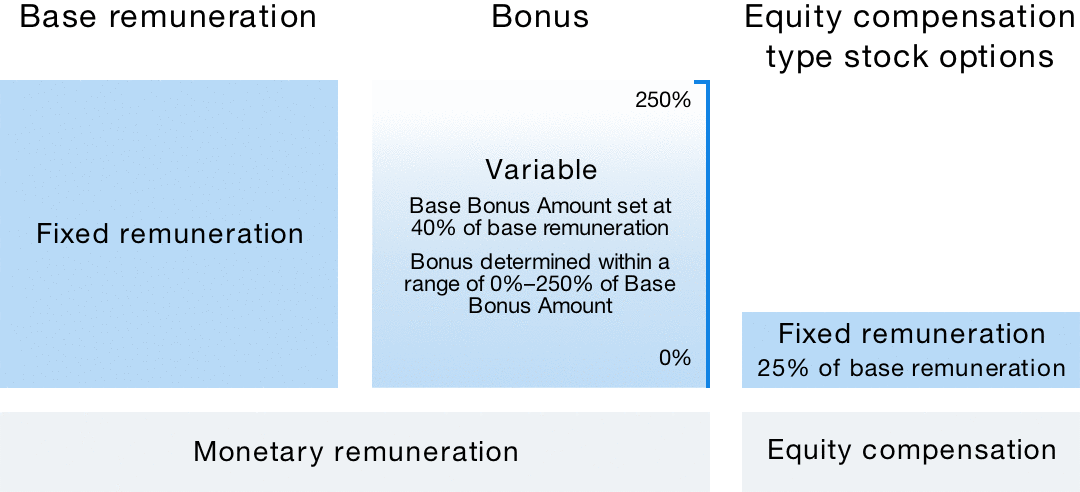

<Reasons for the Board of Directors’ Judgment that Remuneration for Individual Directors in FY2022 was in Accordance with the Above Policy>
The Nomination and Remuneration Committee determined the details of remuneration for individual directors from several perspectives, including an analysis of business target achievements and each director’s contribution to the Bank’s business operations, while ensuring consistency with its policy of determining remuneration. The Board of Directors respected such determination while judging that it was made in accordance with the determination policy.
<Policy on Determination of the Amount and Calculation Method of Remuneration for ASB Members>
ASB members discuss and determine their individual remuneration amounts in consideration of deliberations and proposals made at the Nomination and Remuneration Committee. ASB members only receive base remuneration (fixed remuneration), which is paid on a monthly basis during their tenure in accordance with the policy below.
Base Remuneration (Fixed Remuneration)
Base remuneration comprises a fixed amount which is determined mainly in consideration of the type of position (full-time or part-time) and assigned audit duties as well as the details and levels of director remuneration. Data from an outside specialized agency is used to determine whether the level of base remuneration is appropriate.
<Remuneration of Directors and ASB Members (April 1, 2022 to March 31, 2023)>
|
Category |
Number |
Remuneration in total |
|||
|---|---|---|---|---|---|
|
Fixed remuneration |
Performance-based remuneration |
Non-monetary remuneration |
|||
|
Directors (excl. outside directors) |
4 |
236 |
182 |
7 |
46 |
|
ASB member (excl. outside ASB members) |
1 |
29 |
29 |
ー |
ー |
|
Outside directors |
5 |
56 |
56 |
ー |
ー |
|
Outside ASB members |
2 |
24 |
24 |
ー |
ー |
- The number and remuneration in the above table include those for one director who retired at the close of the 89th General Meeting of Shareholders on June 22, 2022.
- No director or ASB member received a total remuneration of 100.0 million yen or more
While the banking sector continues to experience significant changes in the operating environment, the Aozora Group remains committed to sustainably increasing its corporate value. In keeping with this commitment, the Group needs to promote sound risk-taking while implementing effective risk controls through proper awareness of its business environment and potential risks. The Group has established a risk appetite framework for business management that clearly identifies the type and level of risks (risk appetite) it assumes to achieve its business strategies and financial plan.
Specifically, the Group has developed the Mid-term Plan and annual business plans by comprehensively reviewing stress test results and other factors, while recognizing the expectations of its stakeholders, including shareholders and customers, as well as changes in the external and internal environment, and then determined its profitability, balance of risk-taking and resource allocation. The Bank’s business operations based on its management plan are executed under the guidance of the Management Committee and sub-committees. These committees monitor business operations as well as review progress against the plan and the operating environment, which are also taken into account in subsequent business operations.
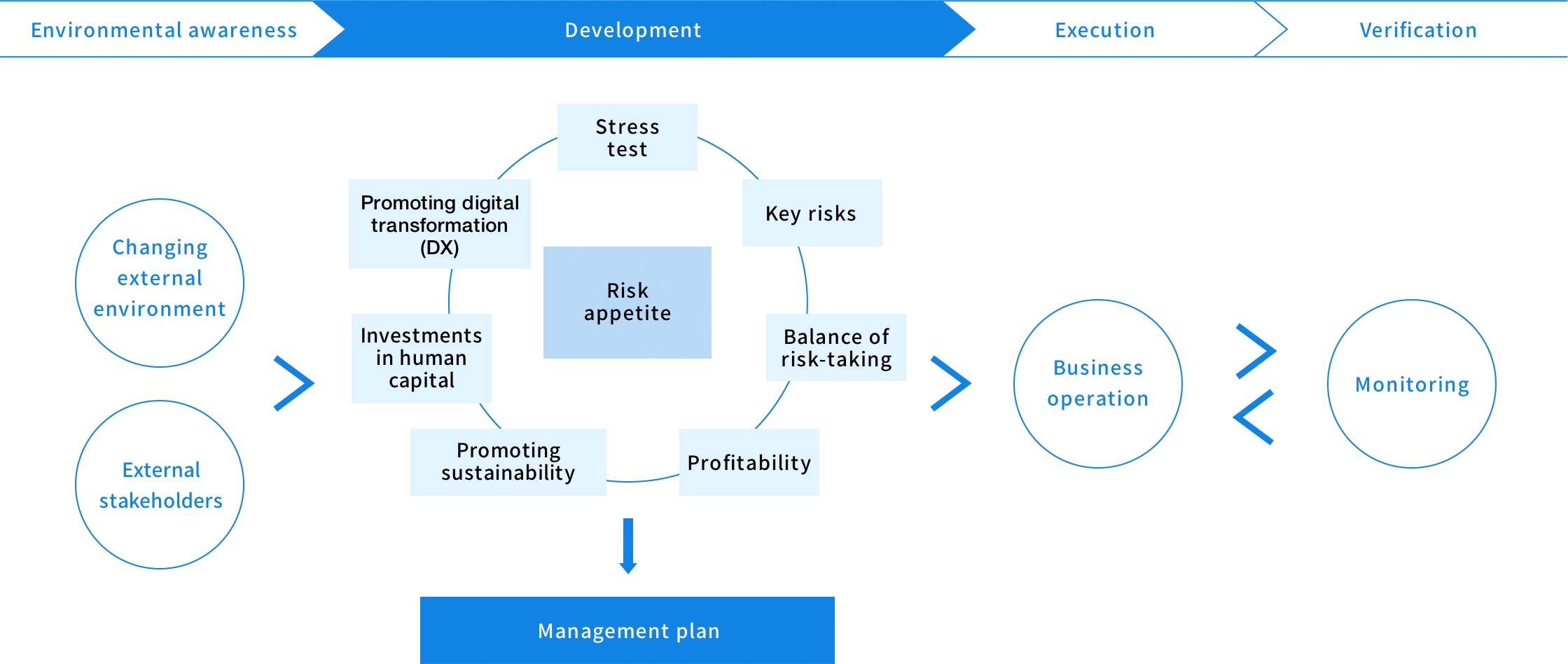

<Role and Function>
The Internal Audit Division (IAD) operates independently from all business groups and supporting units. To help realize the Aozora Mission to “contribute to the development of society through the creation of new value-added financial services,” the IAD objectively examines and evaluates whether the Group’s internal controls are functioning properly and effectively, and offers constructive and practical recommendations for business improvement. As of March 31, 2023, 28 employees were directly engaged in internal audits.
Internal audits are conducted in line with audit plans, which are formulated according to the Annual Internal Audit Plan approved by the Management Committee and the Board of Directors each fiscal year. When formulating the audit plan, the IAD carries out risk assessments based on the type and degree of inherent risk within business groups, supporting units and group companies as well as the status of internal controls, and determines factors such as the frequency, complexity, and deployable resources of audits.
The IAD also performs cross-sectional target audits for each business process and system audits according to the importance of risk management, as well as J-SOX audits that examine the effectiveness of internal controls related to financial reporting. In FY2022, the IAD conducted a total of 79 internal audits, which were comprised of 20 audits for business groups and supporting units, 21 cross-sectional target audits, four system audits, and 34 J-SOX audits. The IAD also carried out three follow-up audits on audit findings.
<Positioning of the IAD within the Organization>
The IAD reports directly to the Chief Executive Officer (CEO) and shares the status of the Group’s internal controls with the CEO mainly through periodic reporting. The IAD also provides an independent evaluation of internal controls by presenting individual audit results to the Management Committee monthly and a summary of the audits directly to the Audit and Compliance Committee and the Board of Directors semiannually.
In order to better fulfill its audit mission, the IAD cooperates with the Audit & Supervisory Board and its members by directly exchanging information and opinions, including sharing the aforementioned audit reports and audit schedules. Furthermore, the IAD strives to work closely with Audit & Supervisory Board members and the accounting auditor by holding periodic group audit meetings where they exchange information and opinions.
<Efforts to Improve Audit Quality and Effectiveness>
The Bank’s internal audits are conducted on a risk basis in accordance with the international standards of the Institute of Internal Auditors (IIA). In addition to an internal quality assessment conducted annually, the IAD periodically undergoes an external quality assessment by a third-party organization in order to further improve the Bank’s internal audits. In FY2022, the IAD received an internal audit quality assessment by an external organization and reflected the findings in the formulation of the new Mid-term Internal Audit Plan, and also enhanced the dual role assignment system between Aozora Bank and the audit divisions of group companies in order to strengthen group governance.
In order to improve the effectiveness of its internal audits, the IAD conducts ongoing internal and external recruitment of auditors with a high level of expertise. In addition, the IAD supports and encourages its audit members to obtain professional certifications, such as Certified Internal Auditor (CIA) and Certified Information System Auditor (CISA).
<Internal Audit System>
